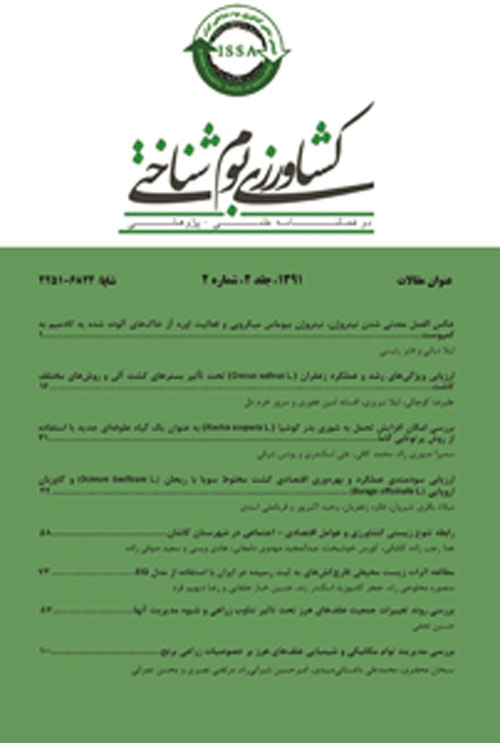Assessment of crop land in Tehran and Alborz provinces for rapeseed cultivation using Geographic Information System (GIS)
Author(s):
Abstract:
Determination of land suitability for cropping purposes through evaluation of climatic، soil and topographic factors is of great importance for developing a sustainable agricultural system. In this research the land suitability of Tehran and Alborz Provinces for rapeseed cultivation was evaluated using the Geographical Information System (GIS). The results of overlaid maps with application of the maximum limitation method based on climatic variables which are necessary for winter rapeseed (active growth degree days from planting until frost period، active growth degree days from planting to flowering، active growth degree days from planting to harvesting of canola، average maximum and minimum temperatures during growing and number of frosted days in the study area) indicated that the most of the land in the study area (34. 85%) in terms of climate is moderately suitable (S2) for rapeseed cultivation. Approximately 30. 17% of the land in the North and the Southeast of the study area is unsuitable (N) for rapeseed growth and development. This occurs because the temperature reaches as low as -26°C in the Shemiranat and Damavand regions and -32°C in the Firouzkooh region during the rosette growth stage of rapeseed and، therefore، not enough growth degree days in the rosette، flowering and harvesting stages are available. In the Southeast of the study area، with temperatures of 27، 30 and 35°C occurring at the flowering، packing pod and maturity stages، respectively، are harmful and، therefore، rapeseed cultivation is not suitable. The results indicated that 18. 51% of the land in terms of climate is suitable (S1) for growing rapeseed. The results of overlaid maps with application of the maximum limitation method for climate، land use، topography and soil variables also showed that approximately 83. 12% of the land is not suitable (N) for cultivation of rapeseed. However، climatic and soil constraints are important limiting factors for cultivation of rapeseed in these areas. Thus، for rapeseed cultivation، only 7. 9% of the land in the study area is suitable (S1).
Keywords:
Rapeseed , Climate , Topography , Land Use , GIS
Language:
Persian
Published:
Journal of Agroecology, Volume:3 Issue: 1, 2013
Pages:
27 to 41
magiran.com/p1410734
دانلود و مطالعه متن این مقاله با یکی از روشهای زیر امکان پذیر است:
اشتراک شخصی
با عضویت و پرداخت آنلاین حق اشتراک یکساله به مبلغ 1,390,000ريال میتوانید 70 عنوان مطلب دانلود کنید!
اشتراک سازمانی
به کتابخانه دانشگاه یا محل کار خود پیشنهاد کنید تا اشتراک سازمانی این پایگاه را برای دسترسی نامحدود همه کاربران به متن مطالب تهیه نمایند!
توجه!
- حق عضویت دریافتی صرف حمایت از نشریات عضو و نگهداری، تکمیل و توسعه مگیران میشود.
- پرداخت حق اشتراک و دانلود مقالات اجازه بازنشر آن در سایر رسانههای چاپی و دیجیتال را به کاربر نمیدهد.
دسترسی سراسری کاربران دانشگاه پیام نور!
اعضای هیئت علمی و دانشجویان دانشگاه پیام نور در سراسر کشور، در صورت ثبت نام با ایمیل دانشگاهی، تا پایان فروردین ماه 1403 به مقالات سایت دسترسی خواهند داشت!
In order to view content subscription is required
Personal subscription
Subscribe magiran.com for 70 € euros via PayPal and download 70 articles during a year.
Organization subscription
Please contact us to subscribe your university or library for unlimited access!


